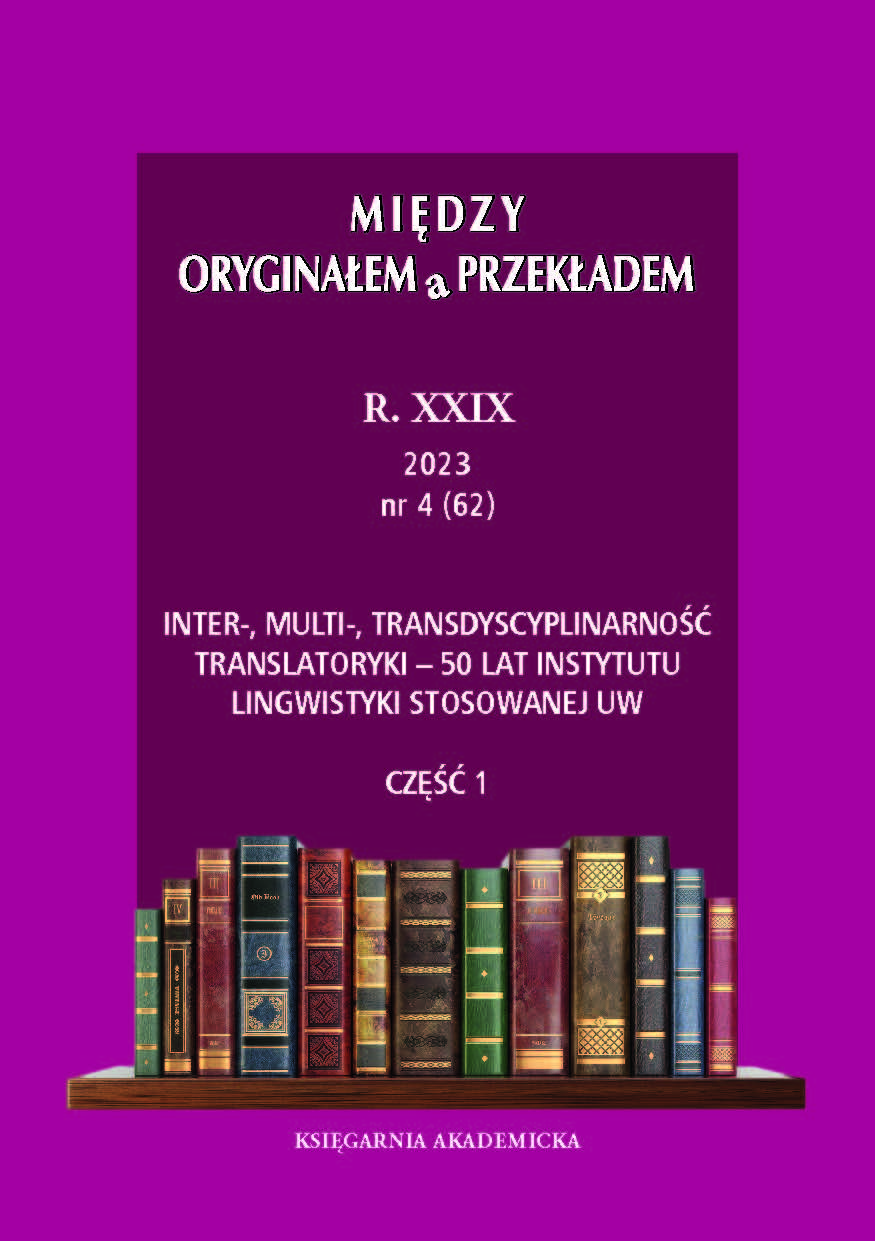On Inconsistencies and Strategies, or How to Translate the Unnatural Naturally
DOI:
https://doi.org/10.12797/MOaP.29.2023.62.03Keywords:
Inconsistency, introspective experiment, naturalness, strategy, think-aloud protocol (TAP)Abstract
This article highlights the results of an experimental study dedicated to analysing the concept of translation naturalness in terms of the processoriented paradigm of Translation Studies. The multidisciplinary nature of modern Translation Studies is revealed through applying methods, concepts, and theories of different areas of knowledge in regard to different translation-related phenomena as well as translation itself. Experimental methods devised by cognitive psychology for exposing the mechanisms of decision-making in complex processes have proven their validity in translatology for the last thirty years. The aim of the study is to investigate the translators’ decisions intended to make their output look more natural. Our hypothesis is that such decisions are in particular motivated by aspiration to eliminate different types of inconsistencies that can potentially result in unnaturalness in the target text. To verify this hypothesis, we developed and conducted an introspective experiment based on the think-aloud methodology. The material for the study was taken from Terry Pratchett’s novel A Hat Full of Sky, within which we singled out three control elements characterised by structural, semantic or stylistic inconsistency. The analysis of the TAPs of ten semi-professional subjects demonstrated that they did not always successfully identify the inconsistencies in the control elements, but when they did, their reaction was to apply strategies aimed at eliminating them and therefore enhancing the target text naturalness.
Downloads
References
Cicero (1949), On Invention, Best Kind of Orator, Topics (transl. H. M. Hubbel), Harvard University Press, Cambridge, Massachusetts.
Clark, E.V., Clark, H.H. (1979), “When Nouns Surface as Verbs”, Language. 55(4): 767-811, https://doi.org/10.2307/412745. DOI: https://doi.org/10.2307/412745
Eco, U. (1994), Six Walks in the Fictional Woods, Harvard University Press, Cambridge, Massachusetts, London.
Ericsson, K.A., Simon, H.A. (1980), “Verbal Reports as Data”, Psychological Review. 87(3): 215-251, https://doi.org/10.1037/0033-295X.87.3.215. DOI: https://doi.org/10.1037/0033-295X.87.3.215
Ericsson, K.A., Simon, H.A. (1987), “Verbal Reports on Thinking”, [in:] Claus Faerch, Gabriele Kasper, eds. Introspection in Second Language Research, Multilingual Matters, Clevedon.
Kussmaul, P., Tirkkonen-Condit, S. (1995), “Think-Aloud Protocol Analysis in Translation Studies”, TTR: traduction, terminologie, rédaction. 8(1): 177-199, https://doi.org/10.7202/037201ar. DOI: https://doi.org/10.7202/037201ar
Newmark, P. (1988), A Textbook of Translation, Prentice Hall International, New York–London.
Nida, E.A. (1969), “Science of Translation”, Language. 45(3): 483-498, https://doi.org/10.2307/411434. DOI: https://doi.org/10.2307/411434
Pratchett, T. (2015), A Hat Full of Sky, HarperCollins, New York.
Rebrіj O.V., Peškova O.G. (2020). “Âk perekladačі graûtʹ v movnі іgri (і peremagaûtʹ): Eksperimentalʹne doslіdžennâ” [Ребрій О.В., Пєшкова О.Г. (2020). “Як перекладачі грають в мовні ігри (і перемагають): Експериментальне дослідження” / “How Translators Play Language Games (and Win): Experimental Research”], The Journal of V. N. Karazin Kharkiv National University: Series “Foreign Philology. Methods of Teaching Foreign Languages”. 92: 82-91, https://doi.org/10.26565/2227-8877-2020-92-11. DOI: https://doi.org/10.26565/2227-8877-2020-92-11
Rebrіj, O.V. (2012), Sučasnі koncepcії tvorčostі u perekladі, Harkіvsʹkij nacіonalʹnij unіversitet іmenі V.N. Karazіna, Harkіv [Ребрій, О.В. (2012), Сучасні концепції творчості у перекладі, Харківський національний університет імені В.Н. Каразіна, Харків / Modern Conceptions of Creativity in Translation, Kharkiv V.N. Karazin National University Press, Kharkiv].
Rogers, M. (1998), “Naturalness and Translation”, SYNAPS – A Journal of Professional Communication. 2: 9-31.
Saptaningsih, N., Nuraeni, A. et al. (2020), “The Extent of Language Naturalness in the Translation of Children’s Storybooks Produced by Novice Translators in Ganesa Library” [paper], Proceedings of the First International Conference on Communication, Language, Literature, and Culture, ICCoLLiC 2020, Surakarta, 8-9 September 2020, http://dx.doi.org/10.4108/eai.8-9-2020.2301412. DOI: https://doi.org/10.4108/eai.8-9-2020.2301412
Venuti, L. (1995), The Translator’s Invisibility: A History of Translation, Routledge, London.
Vinay, J.-P., Darbelnet, J. (1995), Comparative Stylistics of French and English: A Methodology for Translation (transl. Juan C. Sager, M.-J. Hamel), John Benjamins Publishing Company, Amsterdam/Philadelphia, https://doi.org/10.1075/btl.11. DOI: https://doi.org/10.1075/btl.11
Waliński, J.T. (2015), “Translation Procedures”, [in:] Łukasz Bogucki, Stanislaw Goźdź-Roszkowski, et al. eds. Ways to Translation, Łódź University Press, Łódź.
Downloads
Published
Issue
Section
License

This work is licensed under a Creative Commons Attribution-NonCommercial-NoDerivatives 4.0 International License.






